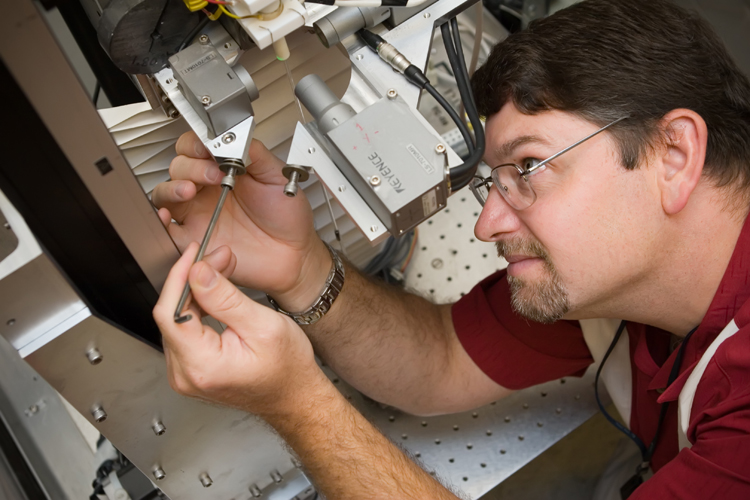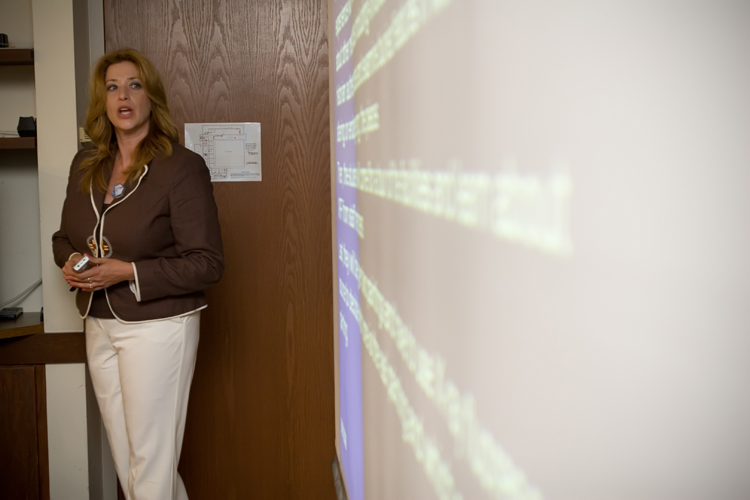X-RAY RUNS: Apply for Beamtime
2017 Nov 1 - Dec 21
2018 Feb 7 - Apr 3
2018 Proposal/BTR deadline: 12/1/17
2018 Apr 11 - Jun 4
2018 Proposal/BTR deadline: 2/1/18
Contact: E. Fontes (ef11@cornell.edu)
Arden L. Bement, Jr., NSF
Director (left) with RET teacher Robert Santavicca
(center) and Donald Bilderback, Associate Director,
CHESS, examining a tapered glass capillary x-ray
focusing optic.
Ithaca, NY -- High school teachers Julie Oberly and Robert Santavicca took a summer break from teaching to put on their thinking caps and learn about x-ray science during a six week visit to CHESS, the Cornell High Energy Synchrotron Source. For their hosts at CHESS, Julie and Robert represent talented “helpful hands” for the summer and a chance to make some real progress on much needed projects.
Bringing them to CHESS is a National Science Foundation (NSF) program called Research Experiences for Teachers (RET). The program encourages teachers to learn about science through hands-on activities and direct interactions with practicing scientists. Julie and Robert were supported by Wayne State University (WSU) and Giovanni Bonvicini, professor of physics and principal investigator on the NSF grant. Bonvicini remarks with pride that 34 teachers participated in the program over 8 years and “[the RET program] always has a big effect on the teachers, with nearly uniform enthusiastic responses to questionnaires.” The hope is that knowledgeable high school teachers will make better science teachers.
Robert Santavicca, a chemistry and physics teacher at the Murray Wright High School in Detroit, Michigan, worked with Donald Bilderback, associate director of CHESS, to develop and refine a new x-ray glass capillary optics drawing tower. Bilderback’s group has built a glass drawing tower takes hollow, straight glass tubes, heats them using a computer controlled furnace, then melts, stretches and tapers the glass into an effective “x-ray funnel”. If properly shaped, the capillaries can focus x-ray beams from the Cornell synchrotron down to very small dimensions, typically 10 microns or less. If the shape is wrong, or the surface is rough, the x-ray beam will scatter or diverge and have little use to scientists.

RET teacher Robert
Santavicca working on the glass drawing tower.
Robert joined the project at the time when the drawing tower was working but had developed a mysterious problem – the glass tubes it made had subtle damaging oscillatory waves in their shapes. He worked with graduate student Sterling Cornaby and technician Tom Szebenyi to search for potential problems. He made a series of new ceramic furnaces, calibrated and characterized its performance. He also designed and built a new baffle shroud to cover the precise linear air bearing in an attempt to prevent turbulent airflow convection through the furnace to disturb the melt zone. The air baffle did have a measurable improvement on the accuracy and repeatability of the capillary shape. Szebenyi remarked “Cutting the air flow this way helped to cut the surface slope errors from 50 microns to fewer than 15. The proof of the pudding will be when [synchrotron x-ray beams] to evaluate the capillaries.”
Robert also had an opportunity to meet the director of the NSF, Arden L. Bement, Jr., on the occasion of his visit to Wilson Laboratory to learn about the particle physics and x-ray science programs. After hearing about the drawing tower and what he had done for the summer, Bement asked about what teachers take back to the classroom. “Interested teachers spark interested students” answered Robert. “The more experiences teachers share the greater involvement our students will gain in the classroom in outreach programs at local universities and web access. In most cases the students do not understand the opportunities that science and physics can bring to their futures… The teachers are there to establish and maintain university contacts.”
With enthusiasm Bement mentioned an upcoming announcement (now on the NSF web site) about a program called “Discovery Research K-12” that funds research, development, and evaluation projects to improve learning and teaching in science. This program is part of the Division of Elementary, Secondary, and Informal Education (ESIE) that “supports the NSF's mission of providing leadership and promoting development of the infrastructure and resources needed to improve preK-12 science, technology, engineering, and mathematics education throughout the United States.” Programs in this directorate show how NSF is dedicated to improving science communications, science teaching and science fluency for the nation at large.
In addition to teaching, Robert also wears the hats of Data Specialist and Science Curriculum Leader. Among his duties as an administrator, he works to facilitate and guide the advancement of science & engineering instruction through research and technology used by teachers and students in the classroom. This past winter he convinced fellow teacher Julie Oberly to try a first RET experience at CHESS.
Julie, a chemistry and biology teacher, worked to developing education and outreach activities for an on-going program in x-ray fluorescence (XRF). XRF measures the spectrum of light emitted by an object while being illuminated by a high energy x-ray beam. The spectrum is unique for each element in the periodic table so XRF can be used to measure the composition of most any material. With this capability, XRF is growing in importance as a tool used by environmentalists to measure trace element contamination in plants and fishes, or by electronics engineers to track impurities that limit the performance of small integrated optoelectronics devices, for instance.

RET teacher Julie Oberly
presenting work on x-ray fluorescence.
Julie spent some time learning about XRF and exploring how fairly simple XRF measurements can be useful in art history and archaeology. Earlier this year, Peter Revesz, staff scientist at CHESS, and John Chiment, from Simple Interests, Inc., prototyped using XRF to teach a group of 100 high school chemistry students about the chemical makeup of stone artifacts. XRF can be used to distinguish arrowhead specimens from different geographic sources, giving historians clues about trade routes and travel in early American and pre-American history. Using this experience as a model, Julie cemented a formal connection between CHESS and the Johnson Art Museum and wrote a field trip information guide for grade school teachers. The guide, distributed to teachers so they can plan an educational trip to Cornell, outlines the background information on the chemistry of art and XRF, describes the national standards addressed by the lessons, and provides materials and questions that can be incorporated into classroom lessons. During the field trip students learn about art history, chemicals and chemical reactions in art, and follow-up at CHESS using XRF to determine between original art work and a forgery. Julie also composed pre-test and post-test exercises and test that can be used to judge the effectiveness of the lesson quantitatively.
Looking for new applications of XRF that might excite K-12 students or fit into their school science curriculum, Julie visited the Johnson Art Museum, the Paleontology Research Institute in Ithaca and the Corning Glass Museum in Corning, NY. Interesting ideas for students to explore include comparing the metal content of coins from different countries, looking for trace metal contamination in plant leaves, and trying to find the metal content of breakfast cereals fortified with vitamins and minerals. She also showed the XRF lab to a group of 22 visiting high school teachers who toured the facility as part of the “CNS Institute for Physics Teachers” summer program run by the NSF-funded Cornell Nanoscale Systems laboratory. They were impressed and many mentioned hopes that they could incorporate some XRF activity into their classroom planning.
“I think she has really gotten a feeling for what research is all about: having an idea, and to make it work one has to go through a number of iterations, trials and errors” comments Peter Revesz, who designed the XRF hardware and computer interface and worked closely with Julie on the project. “…It was interesting for her to see how many modifications an experiment goes through before you get it right.” “She also learned how complex even a simplest experiment can be and sometimes the brightest ideas don't work out in reality.”
Both teachers gave final presentations of their work to an audience overflowing the seminar room. When asked about the benefits the RET program and hosting teachers, Sol Gruner, director of CHESS, adds that “getting an undergraduate excited about science is a wonderful thing to do. But if you give a high school teacher a good science experience, one that can be taken back into the high school to be passed on to many students, then you have a fantastic multiplier effect.”
Also see:
Complete article here (pdf)
online: 10/09/2006
